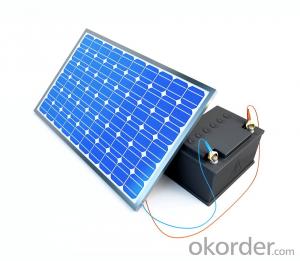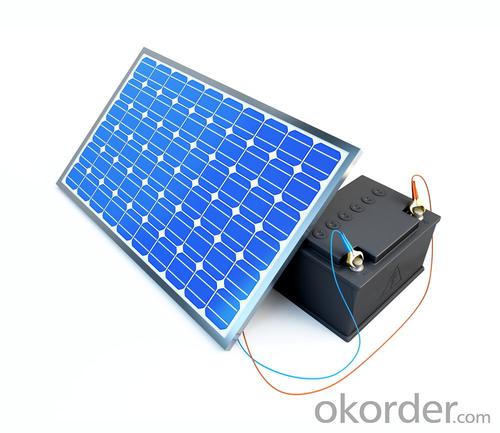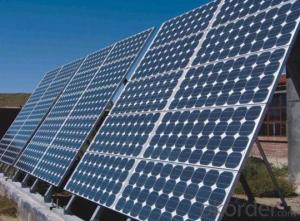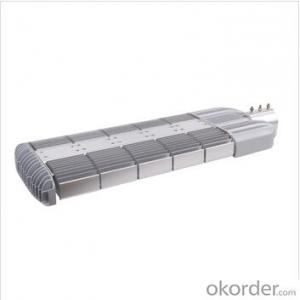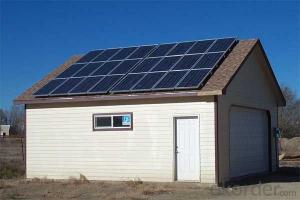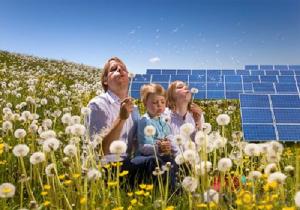Rise Solar Panels 80W Polycrystalline High Efficiency
- Loading Port:
- China main port
- Payment Terms:
- TT OR LC
- Min Order Qty:
- 100 watt
- Supply Capability:
- 1000000 watt/month
OKorder Service Pledge
OKorder Financial Service
You Might Also Like
Specification
Introduction of Poly solar panels CNBM
Polycrystalline Solar Panels 80W With High Efficiency
CNBM Solar photovoltaic (PV) Panel is designed for large electrical power requirements. It is the optimal choice for both on-grid and off-grid power systems. CNBM Solar panel offers high performance of power per square foot of solar array. Monocrystalline silicon(c-Si): often made using the Czochralski process. Single-crystal wafer cells tend to be expensive, and because they are cut from cylindrical ingots, do not completely cover a square solar cell module without a substantial waste of refined silicon. Hence most c-Si panels have uncovered gaps at the four corners of the cells.

Feature
1.Solar Cell : High efficiency crystalline solar cell. Even if under the weak light, the solar module can produce maximum power output.
2.Tempered glass (toughened glass): Anti-reflecting coating and high transmission rate glass increase the power output and mechanical strength of solar module.
3.EVA and TPT: Using high quality EVA and TPT to prevent destroying and water.
4.Long lifetime: ≥25 years; Less power decrease.
5.Resisting moisture and etching effectively, not effected by geology.
6.The certificate issued by international authority: UL, TUV, IEC, VDE, CE.
Main Solar Panel Specification
Characteristics of Poly solar panels CNBM | |||||
Max Power Voltage Vmp(V) | 30.3 | 30.8 | 31.1 | 31.4 | 31.85 |
Max Power Current Imp(A) | 7.60 | 7.64 | 7.73 | 7.81 | 7.85 |
Open Circuit Voltage Voc(V) | 36.1 | 36.6 | 37 | 37.3 | 37.68 |
Short Circuit Current Isc(A) | 8.50 | 8.55 | 8.65 | 8.75 | 8.85 |
Max Power Pm(W) | 230W | 235W | 240W | 245W | 250W |
Temperature Coefficient of Cells Poly solar panels CNBM | |
NOCT | 45℃ ± 2℃ |
Temperature Coeffucients of Isc (%/℃) | 0.0492 |
Temperature Coeffucients of Voc (%/℃) | -0.3374 |
Temperature Coeffucients of Voc (%/℃) | -0.4677 |
Mechanical Data of Poly solar panels CNBM | |
Dimension | 1638 × 982 × 40 mm |
Weight | 19.5 kg |
No. of Cells and Connections | 60 (6 ×10) |
Tolerance | 0 ~ + 5 W |
Cell | Monocrystalline Cell 156 × 156 mm |
Packing | 624 Pcs/40ft(H) Container |
Limits of Poly solar panels CNBM | |
Operating Temperature | -40℃ to +85℃ |
Storage Temperature | -40℃ to +85℃ |
Max System Voltage | 1000VDC(IEC) / 600VDC(UL) |
Guarantees of Poly solar panels CNBM | |
Products Guarantee | 12 yrs free from defects in materials and workmanship |
Performance Guarantee | No less than 90% within 10yrs and no less than 80% within 25yrs |
Certificates | TUV(IEC61215&IEC61730),VDE(IEC61215&IEC61730),UL,CE |
Packaging Information
Package:26pcs/box
Quantity:1 box/pallent
Loading Capacity:952pcs/40ft
- Q: Can solar panels be installed on a residential community or housing development?
- Yes, solar panels can be installed on a residential community or housing development. In fact, many residential communities and housing developments are incorporating solar panels as a sustainable and cost-effective energy solution. Installing solar panels on rooftops or open spaces within the community can generate clean energy, reduce electricity bills, and contribute to a greener environment.
- Q: Solar panels which is the one produces the power...I wanna the complete description about it...
- If you're expecting to use them for anything other than a science fair project, don't bother. In order to produce any significant amount of power, solar panels have to be made of complex materials and coated with special coatings. If you want to power anything with them you'll need an inverter. Solar is not a DIY project (no matter how much those scam kits claim). If you're serious about solar, call your local solar installer and talk to them about it.
- Q: Hello from SO TX.. I would like to know if anyone out there has SOLAR PANELS on their home?I have a 850 sq ft. house. I called Austin to a company that offers panels and installation. The cost $8,000.00, for 0 panels . The rep said we would save about 2 to 25% on our electric bill /mo. We use approximately 980 kw/mo. Our bill is around $40.00 / mo...I really don't think that's a good enough savings. We figure it would take 25 years to recoup our investment.And where we live in TX it does not offer any incentives. The gov. allows you a $2000.00 tx break.
- I'm in the California Foothills and the island of Mindanao... I have both solar panels (electric and water heating) and a single wind-generator since 2000. We actually sell power to PGE in California and are self-sufficient in Mindanao. NOW, I'm confused with YOUR math... you say the Rep. suggests a monthly savings of $35 (25% of $40) which would be $420 / year. If materials / installation are $8,000 less $2000 tax-credit: it would take 35 years to pay off $6,000 at $420 / year. 980 Kwh/ mo is some pretty heavy usage... I'd suggest trying to reduce that. CFT's, lowering your AC setting, no lights if NOT in room, un-plugging stand-by appliances, and upgrading insulation. At our 2000 sq ft California RANCH we only burn 400 Kwh per month, and that includes an 800 sq ft barn (admittedly we heat with a wood-stove). We have 5, Sanyo 200 watt panels (3kw total) and generate an avg 900 kwh / month. SO, we're selling BACK almost 500 kwh mo. to the grid on the photo-cells alone. The kw wind generator averages another 20 kwh / month. I THINK the company YOU are working with is selling the EXCESS electrical-power back to the power-company behind your back !! GOOD LUCK
- Q: So, I've seen cheap solar panel kits for sale from Harbor Freight, and regardless of whether or not I were to buy a set from them or someone else, I was wondering what the process of implementing a small-scale solar system into your household electrical system would be.I've read articles that started out too in-depth or were speaking of systems on a much larger scale.Can it be as easy as buying the panels and inverter, and plugging it into a socket, or is there more to it?Some of the articles I was reading had mentioned having to contract with your electrical supplier, having to have an electrician tie it all in in some special/ necessary way, using a battery pack (would this be necessary for a tied-in system?), or using the system to only power single items, like a water heater, or plugging items into a connected battery-pack, all of which I'm not sure is necessary or needed for what my goals/ means are/ would be.
- Take okorder /... This unit produces 45W for $90. Inverter is extra. Let's say this unit produces that amount of power for a full 2 hours a day, that's 45W * 2h = 540 Wh or 0.54kWh. If I save that from my electrical company, I would pay about 5 cents. $90 then takes 3800 days or 0 years. At that point, you haven't actually made any money, you've simply recovered what you paid out to buy the unit 0 years ago. Yes, electrical power prices will be going up over the long term but the output of this unit is also not going to be 45W over its lifetime (if it even lasts 0 years) so I really question the economics.
- Q: What is the impact of roof orientation on solar panels' performance?
- The impact of roof orientation on solar panels' performance is significant. The orientation of the roof determines the amount of sunlight the panels receive throughout the day. Ideally, solar panels should be installed on a south-facing roof to maximize their exposure to sunlight. East and west-facing roofs can also work, but they may produce slightly less energy. North-facing roofs are generally not suitable for solar panel installation as they receive the least amount of sunlight. Overall, roof orientation plays a crucial role in determining the efficiency and effectiveness of solar panels.
- Q: Can solar panels be used for powering a marina or boating facility?
- Yes, solar panels can be used to power a marina or boating facility. Solar panels are a sustainable and efficient source of electricity that can provide clean energy to run various equipment, lighting, and charging stations at the marina or boating facility. Additionally, solar power can help reduce dependency on fossil fuels and lower operating costs in the long run.
- Q: What specification of solar panel would I need to power a laptop every day? I would need to use it for about 0 hours or so every day. I don't know anything about solar panels, but I am seriously thinking of getting one now and don't know who to ask.
- Ive been employing the comparable photograph voltaic panels for 5 years, have flow some instances so as that they final lots longer than the roofs weve had over us. i'm coaching my young ones a thank you to construct wind turbines, because of the fact we shop having potential failiures whilst the wind blows. and recently its have been given very windy. I can charge banks of battery's and shop my place of work working from dc-ac converters.
- Q: I made three 36 solar cell (3x6 .5V 3.5A) panel and had it hooked a up to an old car inverter. I was on line looking for a cheap grid tied inverter. I came across the Enphase micro inverter and was wondering if i could use one of those. Will it work?
- It won't work for several reasons. ) Enphase needs 24V modules, you made 8V ones. The voltage is too low to turn it on. 2) Only UL listed (or similar lab) panels are allowed to be connected to your house electrical system. Even if you did get them to work with the Enphase, you won't be able to get the system inspected, there is no way it would be allowed to be turned on by the electrical inspector nor the electric company. 3) If you got by obstacles and 2, and you had an electrical fire in your house, it is highly likely your insurance company would not pay you for it, as you used non-UL panels. DIY panels are fine for little back yard projects, but when it comes to your home, buy real ones. The price has dropped so much in the last 2 years, it's not worth it to mess around.
- Q: I need to write a pressuasive essay on why we should use solar panels more than we do. and convince people that their good and stuff.. if u guys could give me some good key reasons why..that would be great.
- I purchased my system because it is a good financial investment. My system will pay for itself in less than 6 years, thanks to a generous rebate from my utility. Now when the nearly 20% rate increase my city just approved goes into effect my bill will go up about $4 a month instead of $40.
- Q: Do I need some type of regulator when the batteries are fully charged.?? The Arco Panels voltage is approx 7VDC at 2.5 amps, Should I limited the voltage to 4VDC???. I would like to connect both panels to up to five batteries at one time...???
- includes info that suggests the panels (actually called modules) are rated at 2 volts. At less than rated load they will put out a higher voltage, as you have seen. Connecting the modules in parallel will give you the same voltage output. Yes you would need something to regulate the output voltage. It will not be cheap.
Send your message to us
Rise Solar Panels 80W Polycrystalline High Efficiency
- Loading Port:
- China main port
- Payment Terms:
- TT OR LC
- Min Order Qty:
- 100 watt
- Supply Capability:
- 1000000 watt/month
OKorder Service Pledge
OKorder Financial Service
Similar products
Hot products
Hot Searches
Related keywords
